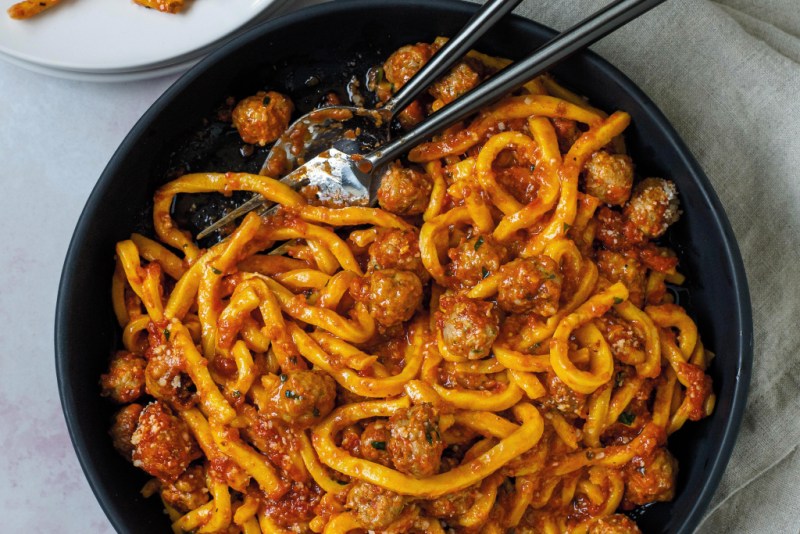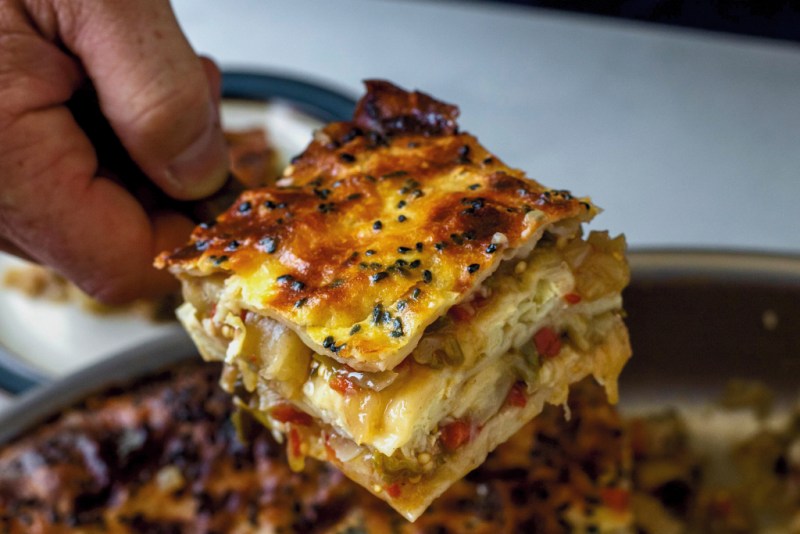
A food media personality and James Beard Award-winning restaurateur, Scott Conant is also a successful cookbook author with multiple bestselling titles to his name. His latest cookbook, Peace, Love, and Pasta: Simple and Elegant Recipes from a Chef’s Home Kitchen
“After cooking professionally for over 35 years, I wanted to create something that could inspire home cooks through the lens of a professional chef,” said Conant. “As you can imagine, I have a substantial repertoire of dishes that I cook for family and friends – we tested lots of different recipes and the greatest hits made the cut for Peace, Love, and Pasta.”
Related Guides
- 5 Classic Italian Pasta Recipes to Make at Home
- What Michelin-Starred Chefs Are Eating at Home
- Celebrated Pitmaster Rodney Scott Lifts the Lid on his Life with The Manual
Many of the recipes in the cookbook feature the diverse cultural background of Conant’s family. While Conant is Italian American, his wife Mel is Turkish. The result is that Conant family meals are a vibrant collection of multicultural flavors, featuring dishes ranging from braised short rib risotto with caramelized onions to eggplant börek (savory Turkish pastry) and cevizli kömeç (walnut bread).
“The dishes in this book reflect all my years working in the kitchen; from my Italian-American childhood to my travels of cooking in Germany, Italy, and Turkey as well as what I make on the regular for my daughters at home,” said Conant.
It took years and much effort by Conant to fine-tune these recipes. While the Italian
Maccheroni with Polpettine and Neapolitan Tomato Sauce

Essentially, this dish is spaghetti and meatballs (Italian style instead of Italian American.) Polpettine (“little meatballs”) are not common in America but Conant is an avid fan, especially “because you get the complete meatball flavor in each bite.” The tomato sauce used in this recipe is also richer, with a savory and hearty flavor profile. Finally, there’s the maccheroni, a pasta that resembles a thick spaghetti. The thickness of this pasta allows it to hold its own against the robust flavors of the sauce and meat. “I like to cut mine shorter than spaghetti as well, so each strand is about 4 to 6 inches long. All together, this is a no-nonsense, fully satisfying plate of pasta—or as I like to think of it, a real nonna dish,” said Conant.
Serves 6
Ingredients:
For Neapolitan Tomato Sauce:
Makes 5 to 6 cups
- 8 oz beef chuck, cut in 2-inch pieces
- .5 medium white onion, sliced into half-moons
- 1 clove garlic, thinly sliced
- 2 celery stalks, sliced
- 1 tsp crushed red pepper
- 1 tbsp dried oregano
- 10 plum or roma tomatoes, quartered
- 1 (15 oz) can puréed tomatoes
- Kosher salt and freshly ground black pepper
- 5 fresh basil leaves
For Polpettine:
Makes about 120 meatballs
- 2 lb prime beef chuck, ground
- 2 tbsp chopped fresh flat-leaf parsley
- 2 slices white bread, soaked in milk for 10 minutes, squeezed, and chopped (about .75 cup)
- 1/3 cup ricotta cheese
- 1 tsp chopped garlic
- 3 tbsp grated Parmigiano-Reggiano cheese
- 1 tsp dried oregano
- 2 large eggs
- Kosher salt and freshly ground black pepper
For Serving:
- Kosher salt
- 1 recipe for Maccheroni (page 97 of the cookbook)
- 6 tbsp unsalted butter
- 6 tbsp extra-virgin olive oil
- 1 recipe for uncooked Polpettine
- 1 recipe for Neapolitan Tomato Sauce
- .75 cup grated Parmigiano-Reggiano cheese
- Freshly ground black pepper
Method:
- Put the beef chuck, onion, garlic, celery, crushed red pepper, and oregano in a large Dutch oven over medium heat, and roast uncovered until the meat is browned, 6 or 7 minutes.
- Add the plum tomatoes and cook for an additional 30 minutes, stirring occasionally so the sauce does not burn on the bottom of the pot.
- Add the canned tomatoes and salt and pepper to taste and cook for another hour, stirring occasionally. Stir in the basil and cook for an additional 5 minutes.
- Remove from heat and purée the sauce using either a food mill or a food processor, and season with salt and pepper. Serve immediately, or store in the refrigerator until ready to use. (The sauce can hold in the refrigerator for about a week, or up to 1 month if frozen in an airtight container.)
- For polpettine, put the ground chuck, parsley, soaked white bread, ricotta, garlic, Parmigiano, oregano, and eggs in a large bowl and mix well with a wooden spoon, or with your hands using food-safe gloves. Season with salt and pepper. (You can also test cook a small patty to taste for seasoning and adjust from that.)
- Scoop out a small amount of meatball mixture and roll into small balls, about the size of the tip of your thumb. Store on parchment-lined baking sheets in the refrigerator until chilled all the way through (about 1 hour), then cook according to the directions at right.
- Bring a large pot of heavily salted water to a boil. (The water should have the salinity of broth.)
- While you wait for the water to boil, in a large pan, warm 3 tbsp of the butter and 3 tablespoons of the oil, then add the polpettine in a single layer and sauté until warmed through and browned. Spoon the polpettine into a separate 6- to 8-inch-deep pan (you can use the pan that the tomato sauce was cooked in, if large enough), add the sauce, and simmer for 5 minutes.
- Add the pasta to the pan and cook until just shy of al dente (about 75 percent done), about 3 minutes. Remove and reserve at least 1 cup of the pasta cooking water, then drain the pasta. (Do not rinse it.)
- Increase the heat under the sauce to medium-high, then add the pasta to the pan along with some of the pasta cooking water, a few tablespoons at a time. Stir to completely coat the pasta with the sauce; when you shake the pan, the sauce and pasta should move together.
- Remove from heat, add the cheese, the remaining 3 tbsp butter and 3 tbsp olive oil, and toss until fully incorporated. Season with salt and pepper to taste and serve immediately.
Eggplant Börek

This Turkish baked pastry can found throughout the region filled with everything from meat to vegetables. The foundation of this pastry is Yufka, an unleavened dough that’s thinner than a tortilla but more substantial than phyllo dough. Yufka dough can be purchased at specialty grocery stores in the freezer section.
Ingredients:
- 6 tbsp plus .5 cup extra-virgin olive oil, plus more for greasing the pan
- 1 large onion, coarsely chopped
- 1 lb mild green peppers (such as Anaheim or Cubanelle), seeded and coarsely chopped
- Kosher salt and freshly ground black pepper
- 3 lb small eggplants, peeled and cut into 1-inch cubes
- 1.5 lb plum tomatoes, halved, seeded, and finely chopped
- 2 large eggs
- 1 pint full-fat Greek yogurt
- 1 lb yufka dough
- 2 tbsp nigella sativa (black cumin seeds)
Method:
- In a large heavy-bottomed pot, heat 6 tbsp of the olive oil over medium heat. Add the onions, peppers, and a pinch of salt and pepper. Sweat the vegetables for about 10 minutes, stirring constantly.
- Stir in the eggplant, season again with little bit of salt, let it brown slightly, then add the tomatoes. Reduce heat to medium-low, cover, and cook until the eggplant is soft, about 15 minutes. Transfer the vegetables to a bowl and let cool slightly.
- Preheat the oven to 400 degrees Fahrenheit and lightly oil a 9-by-13-inch glass baking dish. In a medium bowl, whisk the eggs with the yogurt and remaining .5 cup olive oil.
- Start building layers in the baking dish: Place 1 sheet of yufka dough in the bottom of the dish, then generously brush some egg-yogurt mixture on the dough, being sure to thoroughly coat the bottom. (The yufka will drape over the sides of the pan; it’s okay if it tears a little bit.) Add another sheet of yufka, brush with a little more of the egg-yogurt mixture, then add half of the vegetable mixture. Wrap the sides of the top layer of yufka on top of the vegetables, then generously brush with egg-yogurt mixture (you can pour some of the mixture over the top to make sure the yufka is very well coated). Add the rest of the vegetables and fold the remaining sides of yufka over the top. (If you want a more uniform crust on the top, you can add one more sheet of yufka on top, trimming it so it fits perfectly in the baking dish.)
- Pour the rest of the egg-yogurt mixture over the yufka, brush so that the surface is completely coated, then sprinkle the cumin seeds over the top.
- Bake the börek in the preheated oven until it’s golden brown on top and sizzling, about 45 minutes. Let rest for about 20 minutes before cutting into squares. Serve at room temperature.



